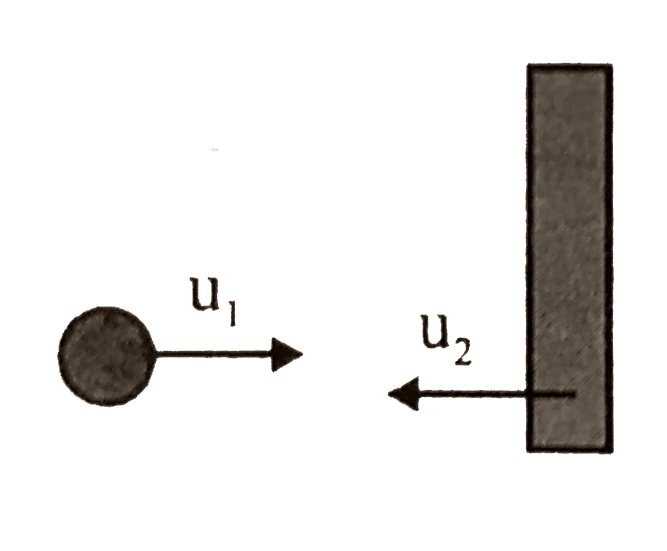Two particles of mass m & 2m have velocities uˆj & uˆi respectively . They collide completely inelastically. Find the loss in kinetic energy of the system.
mu2
23mu2
mu24
mu24
To solve the problem of finding the loss in kinetic energy during a completely inelastic collision between two particles, we can follow these steps:
Step 1: Determine the Initial Kinetic Energy
The two particles have masses m and 2m with velocities u^j and u^i respectively.
- For the particle of mass m moving with velocity u^j:
KE1=12mu2
- For the particle of mass 2m moving with velocity u^i:
KE2=12(2m)u2=mu2
- Therefore, the total initial kinetic energy KEinitial is:
KEinitial=KE1+KE2=12mu2+mu2=12mu2+22mu2=32mu2
Step 2: Apply Conservation of Momentum
In a completely inelastic collision, the two particles stick together. We will find the final velocity of the combined mass.
- In the x-direction:
Initial momentum=(2m)u+0=2mu
\text{Final momentum} = (3m) v_x \quad \text{(where v_x is the final velocity in the x-direction)}
2mu=3mvx⟹vx=2u3
- In the y-direction:
Initial momentum=0+mu=mu
\text{Final momentum} = (3m) v_y \quad \text{(where v_y is the final velocity in the y-direction)}
mu=3mvy⟹vy=u3
Step 3: Calculate the Final Kinetic Energy
Now we can calculate the kinetic energy after the collision.
- The final velocity V of the combined mass can be expressed as:
V=√v2x+v2y=√(2u3)2+(u3)2=√4u29+u29=√5u29=u√53
- The final kinetic energy KEfinal is:
KEfinal=12(3m)V2=3m2(u√53)2=3m2⋅5u29=15mu218=5mu26
Step 4: Calculate the Loss in Kinetic Energy
The loss in kinetic energy is given by:
Loss=KEinitial−KEfinal=32mu2−56mu2
To subtract these fractions, we need a common denominator:
32mu2=96mu2
Thus,
Loss=96mu2−56mu2=46mu2=23mu2
Final Answer
The loss in kinetic energy of the system is:
23mu2
The two particles have masses m and 2m with velocities u^j and u^i respectively.
KE1=12mu2
KE2=12(2m)u2=mu2
KEinitial=KE1+KE2=12mu2+mu2=12mu2+22mu2=32mu2
In a completely inelastic collision, the two particles stick together. We will find the final velocity of the combined mass.
Initial momentum=(2m)u+0=2mu
\text{Final momentum} = (3m) v_x \quad \text{(where v_x is the final velocity in the x-direction)}
2mu=3mvx⟹vx=2u3
Initial momentum=0+mu=mu
\text{Final momentum} = (3m) v_y \quad \text{(where v_y is the final velocity in the y-direction)}
mu=3mvy⟹vy=u3
Now we can calculate the kinetic energy after the collision.
V=√v2x+v2y=√(2u3)2+(u3)2=√4u29+u29=√5u29=u√53
KEfinal=12(3m)V2=3m2(u√53)2=3m2⋅5u29=15mu218=5mu26
The loss in kinetic energy is given by:
Loss=KEinitial−KEfinal=32mu2−56mu2
32mu2=96mu2
Thus,
Loss=96mu2−56mu2=46mu2=23mu2
The loss in kinetic energy of the system is:
23mu2
Topper's Solved these Questions
Similar Questions
Two particles of equal mass m are moving with velocities vˆi and v(ˆi+ˆj2) respectively. If the particles collide completely inelastically, then the energy lost in the process is
View SolutionTwo particles of same mass m moving with velocities u1 and u2 collide perfectly inelastically. The loss of energy would be :
View SolutionA particle of mass m moving with speed u collides perfectly inelastically with another particle of mass 2m at rest. Find loss of kinetic energy of system in the collision.
View SolutionA particle of mass m moving with speed u collides perfectly inelastically with another particle of mass 2m at rest. Find loss of kinetic energy of system in the collision.
View SolutionTwo particles of mass 1 kg and 2 kg are moving with speed 2 m/s and 5 m/s as shown in the figure, they collides perfectly inelastically. And second particle come to rest after collision. Find
(a) Their final velocity
(b) Loss in kinetic energy

View SolutionA ball of mass '2m' moving with velocity uˆi collides with another ball of mass 'm' moving with velocity −2uˆi. After the collision, mass 2m moves with velocity u2(ˆi−ˆj). Then the change in kinetic energy of the system ( both balls ) is
View SolutionTwo bodies of 6kg and 4kg masses have their velocity 5ˆi−2ˆj+10ˆk and 10ˆi−2ˆj+5ˆk respectively. Then, the velocity of their centre of mass is
View SolutionA particle of mass m moves with velocity u1=20m/s towards a wall that is moving with velocity u2=5m/s. If the particle collides with the wall without losing its energy, find the speed of particle just after the collision.

View SolutionA moving particle of mass m makes a head-on perfectly inelastic collision with a particle of mas 2m which is initially at rest. Find the fractional loss in energy of the colliding partic le after collision.
View SolutionFind the equation of the sphere described on the joint of points AandB having position vectors 2ˆi+6ˆj−7ˆkand−2ˆi+4ˆj−3ˆk, respectively, as the diameter. Find the center and the radius of the sphere.
View Solution

